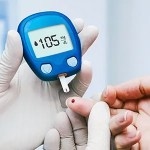Word Count: 1221
Read Time: Approximately 6 minutes
Table of Content:
- Normal Blood Sugar Levels Chart by Age and Health Status
- Why is Monitoring Blood Sugar Important?
- How Are Blood Sugar Levels Measured?
- Tips to maintain Normal Sugar Level?
- Conclusion
- Frequently Asked Questions
Ever wondered what keeps your body fueled and energised throughout the day? It is your blood sugar. Blood sugar refers to the glucose circulating in your bloodstream and is measured in mg/dL.
This vital energy source comes from the foods you eat and is carefully managed by hormones like insulin. Maintaining stable blood sugar levels is not just about feeling your best; it is a cornerstone of overall health, as both very high and very low levels can lead to serious health concerns. With blood sugar playing such a crucial role, it is essential to know the sugar level – normal value for your age and health, as well as why regular blood sugar monitoring is important.
Normal Blood Sugar Levels Chart by Age and Health Status
Below are blood sugar level charts categorised for healthy individuals, those with diabetes and different age groups.
Normal Blood Sugar Levels Chart for Adults (Non-Diabetic)
| Condition | Normal Blood Sugar Range | ||
| Normal Blood Sugar Level before Fasting | 70-100 mg/dL | ||
| Normal Blood Sugar Levels after Eating | 1 hour after a meal | 90-140 mg/dL | |
| 2 hours after a meal | 90-130 mg/dL | ||
| 4+ hours after a meal | 70-100 mg/dL | ||
Normal Blood Sugar Level for a Diabetic Patient
| Diabetes Level Charts: Group | Fasting Blood Sugar Level | Normal Blood Sugar Level for Diabetics after Food |
| Children | Up to 150 mg/dL | 160 mg/dL or above |
| Adults | 126 mg/dL or above | 200 mg/dL or above |
Normal Blood Sugar Levels Chart by Age
| Age Range | Normal Blood Sugar Level before Food | Normal Blood Sugar Level after Food |
| 0-3 years | 60-110 mg/dL | 60-180 mg/dL |
| 3-12 years | 70-140 mg/dL | 70-180 mg/dL |
| 13-13 years | 70-140 mg/dL | 70-180 mg/dL |
| 20-59 years | 70-130 mg/dL | 70-180 mg/dL |
| 60+ | 80-120 mg/dL | 90-150 mg/dL |
Normal Blood Sugar Levels During Pregnancy Chart
| Time | Normal Blood Sugar Level for Female during Pregnancy |
| Fasting (before meals) | Up to 95 mg/dL |
| 1 hour after a meal | Up to 180 mg/dL |
| 2 hours after a meal | Up to 155mg/dL |
| 3 hours after a meal | Up to 140mg/dL |
Why is Monitoring Blood Sugar Important?
Regular monitoring of blood sugar levels helps in several ways, such as:
- Preventing Diabetes and Complications: A sugar level higher than the normal sugar level in the human body can lead to type 2 diabetes, nerve damage, kidney disease and heart problems.
- Maintaining Energy and Mood: Fluctuations in blood sugar can cause fatigue, irritability and difficulty concentrating.
- Designing the Treatment Plan for Diabetics: People with diabetes need to match their blood sugar with the diabetes blood sugar chart to adjust medication, diet and lifestyle to manage their condition.
How Are Blood Sugar Levels Measured?
Blood sugar is typically measured in milligrams per deciliter (mg/dL) or millimoles per litre (mmol/L) using a glucometer or via a blood test. Ideally, the tests should be completed at a nearby diagnostic centre.
Here are the preferred types of blood tests that help determine your blood sugar levels.
- Fasting Blood Sugar: Taken after not eating for at least 8 hours, this test helps determine the normal blood sugar level in the human body, which is between 70–100 mg/dL for most healthy adults.
- Postprandial (after-meal) Blood Sugar: Taken 1–2 hours after eating, this test measures how your body processes glucose after a meal.
- Random Blood Sugar: Taken at any time, regardless of when you last ate, for a quick snapshot of your glucose status.
- HbA1c Test: Measures your average blood sugar over the past 2–3 months, offering a long-term view of your blood sugar control.
You must always refer to normal sugar level range charts and consult your healthcare provider for personalised advice.
How to Check Blood Sugar Level at Home?
For daily monitoring, many people use a glucometer normal blood sugar level as a guide.
It is important to note that the normal blood sugar levels for women are generally the same as for men, but may differ during pregnancy or under certain health conditions.
Here’s how you can use a glucometer:
- Wash Your hands
- turn on the glucometer and insert a new strip into it
- prick yourself in any finger and deposit the blood sample at the edge of the strip
- wipe away any remaining blood and wait for the meter to record your blood sugar level.
Tips to Maintain Normal Sugar Level?
Here are practical tips for keeping your blood sugar in the normal range:
- Eat a Balanced Diet: Focus on fibre-rich foods like vegetables, fruits, whole grains, beans and nuts that make a balanced diet, which slows sugar absorption and helps maintain steady glucose levels.
- Limit Sugar and Refined Carbs: Reduce intake of sugary drinks, sweets, white bread and processed snacks to avoid sudden spikes in blood sugar and maintain a normal blood sugar level.
- Exercise Regularly: Engaging in physical activity improves insulin sensitivity, enabling your body to utilise glucose more effectively. Aim for at least 150 minutes of moderate exercise per week.
- Stay Hydrated: Drinking water supports kidney function and helps regulate blood sugar.
- Prioritise Sleep: Adequate rest is crucial to manage blood sugar levels, as poor sleep can lead to insulin resistance.
- Manage Stress: Stress hormones can raise blood sugar levels; therefore, practice relaxation techniques such as breathing exercises or meditation.
- Monitor Portion Sizes: Eating moderate portions at regular times helps prevent overeating and blood sugar fluctuations.
Following these simple habits supports a healthy and balanced lifestyle, which in turn helps maintain the normal sugar level range in the human body.
Conclusion
Understanding and maintaining normal blood sugar levels for adults is crucial for supporting your overall health and well-being.
For most adults, the normal blood sugar level before a meal typically falls between 70–99 mg/dL. In contrast, post-meal normal blood sugar levels for non-diabetics should ideally remain under 140 mg/dL.
The normal sugar level for females is generally the same as for males, except during pregnancy, when tighter control is often recommended. If your blood sugar readings are outside the healthy ranges, PlatinumRx is here to help.
With reliable medications for diabetes care, an online free doctor consultation facility and convenient home delivery, PlatinumRx makes maintaining your blood sugar level simple and stress-free.
Take the next step toward balanced living. Visit PlatinumRx and let us support your journey to better health.
Frequently Asked Questions
What is a Normal Blood Sugar Level Immediately after Eating?
A normal blood sugar level after a meal for most healthy adults is below 140 mg/dL two hours after eating. Immediate post-meal spikes may be higher, but according to the normal blood sugar levels chart after eating, the levels should return to this range within a couple of hours for optimal health.
What Level of Blood Sugar is Dangerous?
A blood sugar level above 300 mg/dL (too high) or below 70 mg/dL (too low) is generally considered dangerous. Both extremes can cause serious health issues and require prompt attention or medical care.
What is the Normal Blood Sugar Level for a 60-year-old Male?
A blood sugar level for age 50 to 60 of up to 130 mg/dL may be acceptable depending on health status and doctor’s advice.
What is the Normal Blood Sugar Level for a 40-year-old male?
For a healthy 40-year-old male, the normal fasting blood sugar and random blood sugar levels are generally 70–100 mg/dL and 90-180 mg/dL, respectively.
References:
https://asianheartinstitute.org/blog/blood-sugar-level-chart-by-age/
https://www.northeastmedicalgroup.org/articles/what-is-healthy-blood-sugar
https://www.medanta.org/patient-education-blog/normal-glucose-levels-after-eating
https://www.who.int/data/gho/indicator-metadata-registry/imr-details/2380












